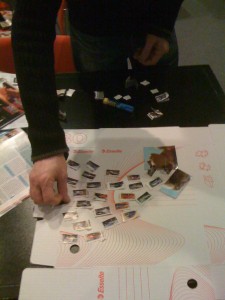
"Prototyping with Junk" at UC Berkeley
Award for Junk
Did you catch the New York Times word of the year (WOTY) for 2010? It’s junk! The editors of the “On Language” column chose this word as representative of the zeitgeist of the past year. The honor acknowledges the basic meaning of rubbish or trash, debris or detritus, as well as extended meanings: From junk bonds (devalued securities) to junk food (nutritionally empty), to junk shot (stuffing debris and mud into BP’s leaking gusher in the Gulf). Their award called out one euphemistic sense, the male genitalia. The TSA started full body pat-downs in 2010, as an alternative to scanning, and air travelers gave warning, “Don’t touch my junk.”
Next month I’ll be hosting the activity “Prototyping with Junk” at Interaction Design 2011 (IxD11) in Boulder, Colorado. As I’ve previously written, I occasionally get pushback from people who feel junk is not appropriate language for professional settings. Or, perhaps their reaction is that junk — the actual stuff — is not for the workplace. Now I can respond to those objections with the citation of WOTY2010. I’m hip!
JunkFest (2007)
And I’m in good company: Bernie DeKoven, author of Junkyard Games, and funsmith extraordinaire, recently shared a video from 2007 celebrating Junkyard Sports. Here’s an news report from JunkFest in Redondo Beach [warning: narration lacks captions]
Kinetic sculpture with junk
Another wonderful example of how using apparent junk (PVC pipes plus a bunch empty plastic bottles, and other stuff) can turn into something magical: see how kinetic sculptor Theo Jansen simulates animals walking, powered by the wind near the sea.
[warning: narration lacks captions]
Read more at Talking Science: Dance of the Strandbeests, the BBC article about this project.
Jansen’s example shows how prototypes evolve into working “products” or art, depending on your perspective. His process of successive refinements suggest agility: at each juncture, he stops and tests his creatures, from human-propulsion of walking machines to wind-propulsion (which simulates self-propulsion), and all from vernacular materials with clever engineering.
Learning with junk
We used Prototyping with Junk at ACM CHI2004 (in Vienna, Austria), when we challenged the participants in the pre-conference design collaboration to create a product for elders. As I’ve written for interactions magazine special issue on prototyping, this is an opportunity for creativity and fun in a social context. And, it’s yet-another communication tool for your collaborative design kit.
More recently, students at UC Berkeley’s iSchool engaged in Prototyping with Junk as one among many prototyping techniques they experimented with this past fall. You can see still images and a few short movies. Notice all those smiles!
Eager to meet the group in Boulder. I’ll bring one of the several design challenges I’m currently mulling over, …and plenty of junk.
